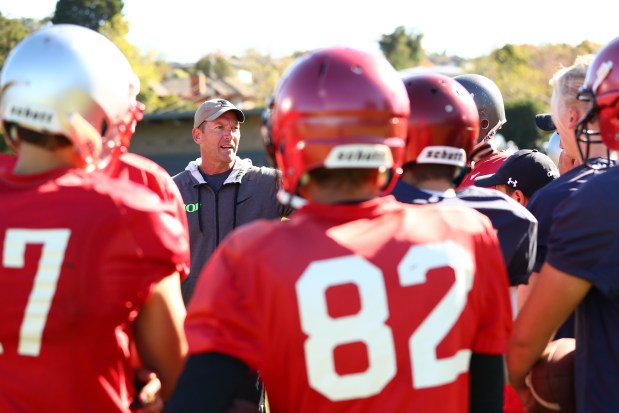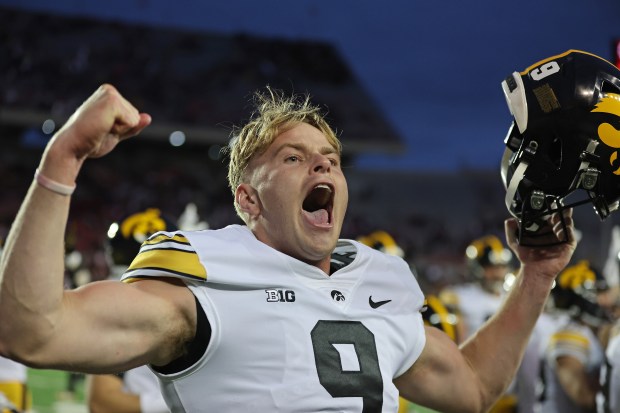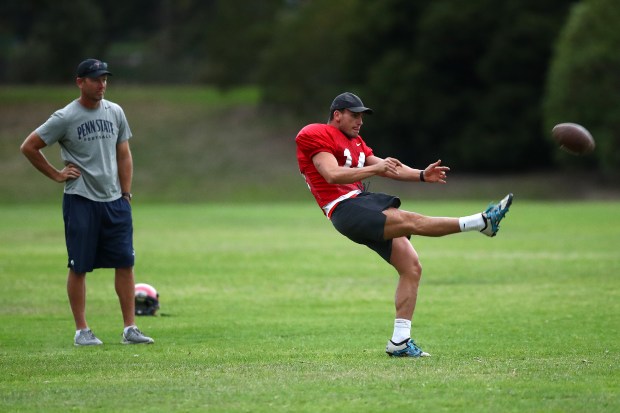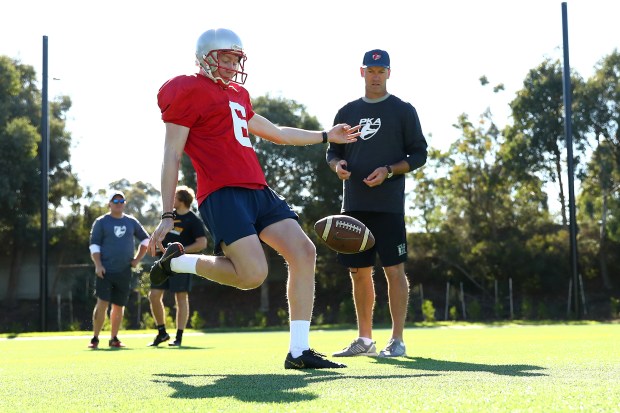LONDON — Standing on the sideline at the 5-yard line with his back to the field, Nathan Chapman could boomerang kick a football over his head and — get this — through the uprights at the Green Bay Packers practice fields.
John Bonamego, the Packers special teams coordinator at the time, swears it happened.
He witnessed it. With amazement.
And Bonamego believes if Chapman — who was a 28-year-old former Australian rules football player when he was on the Packers offseason roster in 2004 — had started his NFL journey sooner, he no doubt would have made it as a punter.
“Chappy was really, truly that talented,” said Bonamego, who spent 19 years as an NFL special teams coach and had a four-year stint as Central Michigan’s head coach. “The guy could do anything with a football. Not to mention the fact that he was ambipedal (the equivalent of ambidextrous with your feet). He punted right-footed but Chappy would warm up left-footed.
“I am sitting there watching this guy do punt passes — kind of your warmup drill, which is nice and easy — and he’s spiraling punts, four-second hang time, 40 yards with his left foot. I’m like, ‘Holy (smokes)!’ He says, ‘Yeah, mate, I do it to loosen up me hips.’”
The Packers wound up releasing Chapman after the preseason — they had drafted B.J. Sander in the third round, a mistake they soon realized. In the next two years Chapman had a tryout with the Chicago Bears during rookie minicamp in 2005 and a workout for the Cincinnati Bengals. No offers materialized.
Chapman and his father, Paul, stayed at the home of then-Bears left tackle John Tait during the 2005 tryout. They hailed from Bendigo, Australia, the same city as Tait’s father-in-law, but Chapman wasn’t going to unseat veteran punter Brad Maynard.
“Learning what to do and how to do it, I could have done it better,” Chapman said earlier this month from Melbourne. “I could have prepared better. I could have worked out how to navigate the system and given me a bit more time and longevity there.
“Spent a few years, spent a fair bit of money to make it work. Ran out of time and money.”
While he ran out of resources, he wasn’t short on ideas. Chapman knew guys who could adapt to punting. He had an inkling of what the NFL was seeking and figured he could train them.
He asked Bonamego and John Dorsey, then the Packers college scouting director whose idea it was to give Chapman a look in Green Bay, if they’d be interested in checking out punters he worked with. Absolutely, they said.
That’s how ProKick Australia, the supplier of an increasing number of college and NFL punters — including Bears rookie Tory Taylor — was born.
The NFL’s global reach puts the Bears in the spotlight Sunday morning, when they play the Jacksonville Jaguars at London’s Tottenham Hotspur Stadium, the third of five international games in three countries this season.
League rules allow for as many as eight international games, a number Commissioner Roger Goodell could seek to increase in the near future, with Spain, Ireland, France, Australia and Asia being considered as future destinations.
This is the Bears’ third game in London since 2011. The NFL had a Week 1 game in São Paulo, Brazil, and will head to Germany in Week 10.
As the league seeks to grow revenue streams worldwide and teams work to gain a foothold elsewhere — the United Kingdom and Spain are part of the Bears’ Global Market Program, which grants them international marketing rights in those countries — no one is supplying more international talent to rosters than Chapman.
Taylor, the NFL special teams player of the week last month for his big effort in a win over the Los Angeles Rams, is one of five Australian-raised punters in the NFL, including the Pittsburgh Steelers’ Cameron Johnson, who is on injured reserve. And simple math tells you more are on the way, as 85 punters trained by ProKick are currently on NCAA Division I rosters at the FBS and FCS levels.
Chapman doesn’t have the only organization Down Under teaching the art of fourth down to strong-legged Australian youth, but he’s the most prolific and the go-to guy for colleges that haven’t found the punter they’re seeking on American soil.

Australians have been punting in the NFL for quite some time. Darren Bennett broke in with the San Diego Chargers in 1995 and became a two-time Pro Bowl selection who was named to the franchise’s 50th anniversary team. He’s credited with introducing the drop punt to the NFL, a standard kick that all now use.
Mat McBriar, Ben Graham and Sav Rocca followed. What was once a novelty, having an Australian on the roster or in camp, is now normal.
Iowa special teams coordinator LeVar Woods, who was with the Bears in the 2005 offseason, practically has Melbourne in his recruiting territory. The Hawkeyes first had an Aussie punter in 2019, when Michael Sleep-Dalton, who trained at ProKick as a youth, joined the program as a graduate transfer from Arizona State.
Seeking to replace him, Woods made the 27-hour journey to Australia.

“I watched Tory punt,” Woods said. “He kicked about 100 balls at a park. I was floored at how easy it was for him but how innocent he was. He knew nothing about American football.
“When he got here, we tried to keep it in his wheelhouse, what he knew, and compare it to what he knew. Every practice he went to was a brand-new experience. The first game he ever saw he actually played in. Think about it. That’s pretty crazy.”
As Taylor wrapped up a record-setting career at Iowa last year, Woods was on a plane again to Melbourne to find his next punter, who turned out to be Rhys Dakin, another ProKick trainee.
“I’m not the smartest guy,” Woods said of recruiting punters. “But I am not a dumb guy either.”
The pipeline to colleges didn’t open right away for Chapman, who partnered with John Smith, a kicker, in forming ProKick in 2007. At the time, three punters were training with them and they were targeting NFL openings.
Chris Bryan was one, and he ended up punting for the Tampa Bay Buccaneers for four games in 2010. The first punter ProKick sent to a U.S. college was Jordan Berry, who went to Eastern Kentucky before a seven-year career with the Steelers and Minnesota Vikings.
“I get a call from Chappy: ‘Bono, I’ve got these three guys and we’re going to come over. Can I get a workout?’” Bonamego said. “It dawned on me: ‘I appreciate what you’re trying to do, but I really think you’re targeting the wrong market. I know your guys are good, but in any given year, there may only be two to three jobs open in the NFL. There’s very little turnover. I think you need to target the colleges.’”
“Really, mate?” Chapman said. “Can you introduce me to some college guys?”
Bonamego provided a list of special teams coaches he knew well, and ProKick’s model quickly shifted.
“Next thing you know, guys start popping up on college rosters,” said Bonamego, who took over the Chippewas program in 2015. “That was one of the first calls I made at Central Michigan, to Chappy.
“‘Well, what do you want? A righty? A lefty? A spiral/turnover guy?’ He’s got a menu and it’s shopping for whatever you want.”

Seattle Seahawks punter Michael Dickson moved from Sydney to Melbourne to train with ProKick. After 3½ months, he was off to the Texas Longhorns in 2015. Most trainees, including Taylor, spend 12 months in the program before they’re ready to start college life and begin playing a sport they’ve never played on the other side of the world.
Taylor said training was three days a week and he usually attended an optional fourth day. He declined to detail the cost. Colleges don’t pay ProKick any sort of finder’s fee.
“I don’t want to give a numerical value,” said Taylor, who was 20 and working a construction job while studying the art of punting. “It’s nothing crazy. I paid for it. I wanted it to be my thing.”
What makes Australians so skilled at punting that they’re scooping up spots on college rosters and beginning to win more jobs in the NFL?
“We grow up throwing the football and they grow up over there kicking the ball,” said Bears special teams coordinator Richard Hightower, who met Chapman when he coached ProKick graduate Mitch Wishnowsky as the San Francisco 49ers special teams coordinator.
Chapman, like the vast majority of players he trains, grew up playing Australian rules football — sort of a combination of rugby and soccer — and was the second pick in the 1992 draft by the Brisbane Bears, beginning an eight-year professional career.
If an Australian father says to his son, “Let’s go outside and play catch,” they go outdoors and kick the ball back and forth to one another.

“If you watch any of the (Australian) guys, they can get out of trouble when they have to scramble,” Chapman said. “If need be, they can kick left- and right-footed. If they need to kick it across their body or over their head, they can do it. So there are some skill sets we learn when things get a little pear-shaped. There is a real touch to it.
“If you watch our guys trying to kick inside the 20, they actually have the ability to say, ‘I’m just going to land this on the 3-yard line,’ and have that depth and touch to be able to do so. Because we’re always kicking for placement or kicking the ball to someone — hand-eye and foot coordination, how we’ve got to get the ball from A to B — there’s a lot more natural instinct to do so.
“There’s a ton of American guys who are very powerful and can kick a ball, but I’d say we have an advantage when it comes to being very accurate with placement and touch.”
Eight of the last 11 winners of the Ray Guy Award, given annually to college football’s top punter, were Australians, including Taylor last year. The increasing number of Aussies kicking for college and NFL teams has created a tight-knit community for the specialists.
Taylor is close with Dickson and they communicate regularly. Taylor also keeps tabs on Dakin at Iowa as they all try to help one another.
“Any Aussie guy coming out of college and coming into the league, I just want to make sure that if they have any questions, I am happy to share the info,” Dickson said.

ProKick has about 80 punters in the program now, many no doubt headed for a college roster in the near future.
“They’ve got it down,” Bonamego said. “They have a woman on staff that used to work with NCAA compliance, so they’re on top of the clearinghouse. It’s seamless. If you’re a college coach and you’re in the market for a specialist and you’re striking out on guys locally, it’s the cheat code.”
Tait, who wasn’t home at the time Chapman and his father used his house and car in 2005, marvels at what has happened for the onetime Bears tryout player.
“I remember (former Bears contract negotiator) Cliff Stein asking me when I got back in town: ‘Hey, I thought I saw your car going down Field Drive (outside Halas Hall) on the wrong side of the road. That wasn’t you, was it?’” Tait said. “I had to laugh and assume it was Paul getting confused on what side of the road to drive.
“Nathan told me of his idea of training Aussie rules players to be punters, and I have to admit I wished him well but internally didn’t think anything would come of it. A bit of a pipe dream. But he proved us all wrong. How often does one person get to put a dent in the football universe like he has?”
Scouting report

Brian Thomas Jr., Jaguars wide receiver
Information for this report was obtained from NFL scouts.
Brian Thomas Jr., 6-foot-2, 209 pounds, is a rookie the Jaguars drafted with the No. 23 pick out of LSU. He was the fourth of seven wide receivers selected in Round 1 after leading the nation with 17 touchdown receptions last fall.
Thomas is coming off a five-catch, 122-yard game with a touchdown in the Jaguars’ win over the Indianapolis Colts and has scored in three of five games. He’s averaging 18 yards per catch.
“Going back to the draft class, he was overshadowed because of Marvin Harrison and Malik Nabers,” the scout said. “He’s played well the last few weeks because why? The quarterback, Trevor Lawrence, has played a little better. When Lawrence plays on time and can set his feet and be more mechanically sound than he’s been in the past, that is going to make the passing game go.
“The thing about Thomas is he’s got really good third-level and vertical-level ability. He can separate late, which is critical in running vertical routes. He’s got an extra gear when the ball is in the air and he’s excellent at tracking the ball.
“More than that, he’s pretty smooth and fluid for a guy who is 6-foot-2, 209 pounds. He can sink his hips, get in and out of his breaks and run the deep in-breakers and create enough separation to work in the middle of the field. And he’s always going to have home-run ability. He can flip the field at any time and he’s going to win one-on-ones. With his frame he’s doing a much better job of playing through contact than I expected as a rookie, whether that’s press coverage or working through a second-level defender trying to reroute him.”



